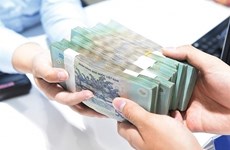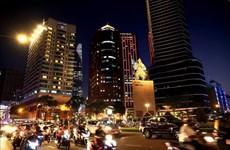Growth attracts foreign capital for Vietnamese banks: Fitch
Fitch Ratings has released a report on Vietnam’s banking sector, saying that Vietnam’s strong economic performance is helping the country attract much-needed foreign capital into its banking system.
 Customers at VietinBank (Illustrative image. Source :VNA)
Customers at VietinBank (Illustrative image. Source :VNA)According to Fitch, banks are likely to need additional capital as they respond to the phasing-in of Basel II capital adequacy standards by end-2018, while trying to meet demand for rapid credit growth.
GIC, a Singapore sovereign wealth fund, signed a memorandum of understanding on August 29 to buy a 7.7 percent stake in Vietcombank, Vietnam’s largest bank by market capitalisation.
The deal follows the recent purchase of a 5 percent stake in a much smaller bank, TienPhong Bank, by the International Finance Corporation.
This injection of foreign capital is a positive trend and comes at a time of strong economic growth, which has helped to stabilise asset quality.
“We forecast real GDP growth of 6.2 percent in both 2016 and 2017. Healthy economic growth plus a recovery in the real estate market are likely to lead to a slower NPL formation, at least in the short term,” Fitch said on August 31 , adding that liquidity and funding conditions should continue to be supported by local-currency stability and benign inflation.
Fitch’s outlook for the banking sector was revised to stable from negative in December 2015 to reflect these conditions.
Nevertheless, Vietnam’s banks are still facing a range of structural problems, not least of which is weak capitalisation. Published capital-adequacy ratios (CAR) are low and under-reporting of NPLs suggests that true capitalisation is even weaker. Capital buffers are likely to come under pressure over the next couple of years.
Ten banks have been designated by the central bank to move to Basel II, with full adoption expected by end-2018, and Fitch believes that the banks’ CARs would be pushed lower by the shift to a more conservative regime.
Those banks with CARs close to the 9 percent regulatory minimum will need more capital. Vietcombank, for example, had a CAR of just 9.7 percent under the Basel I regime at end-June 2016 and Basel II is likely to have been one of the key motivations for its deal with GIC.
Rapid credit growth is also creating a need for more capital. Private-sector credit grew by an average of 16.4 percent per year during 2010-14 and rose by 17.3 percent in 2015. Another pick-up is likely in 2016, with the official target for the year set at 18-20 percent.
Fitch warned that rapid credit growth poses a risk to Viet n am’s medium-term financial stability, particularly since the credit/GDP ratio - at 110.5 percent in 2015.
A sustained rise in foreign appetite for Vietnam’s bank equity would be a positive development because the banking sector has significant recapitalisation needs, Fitch said.-VNA













